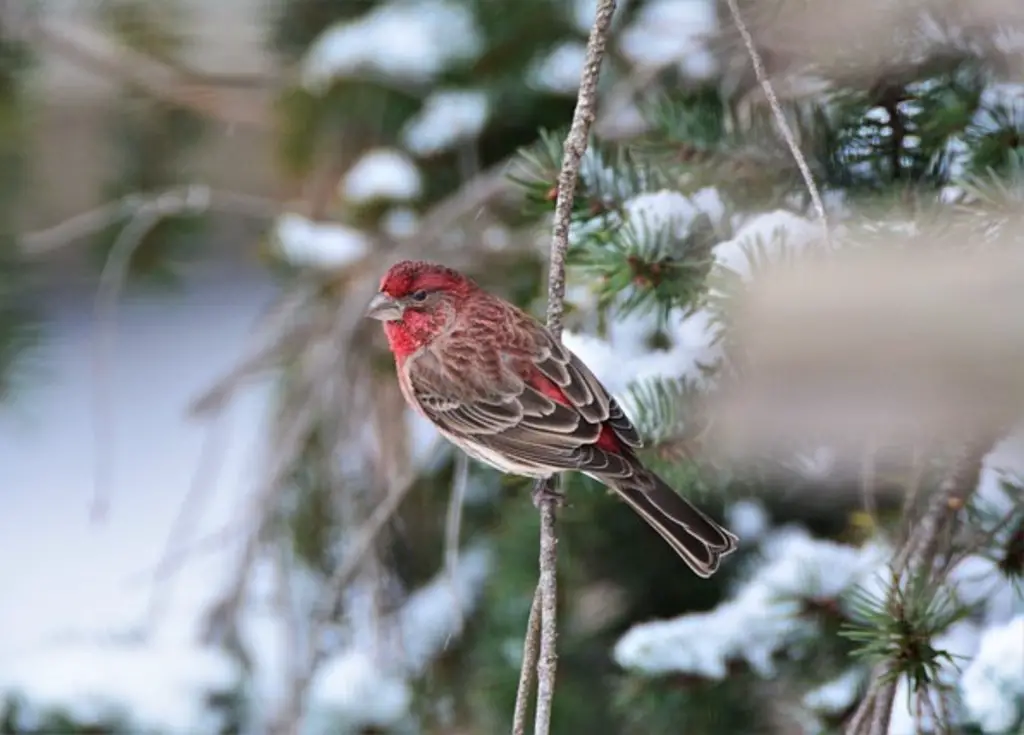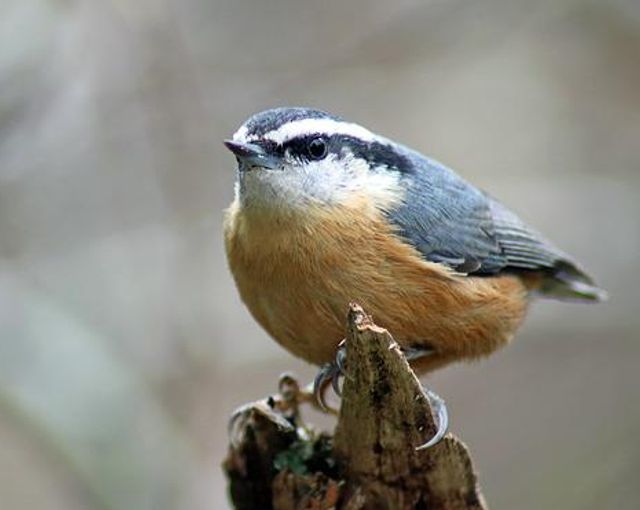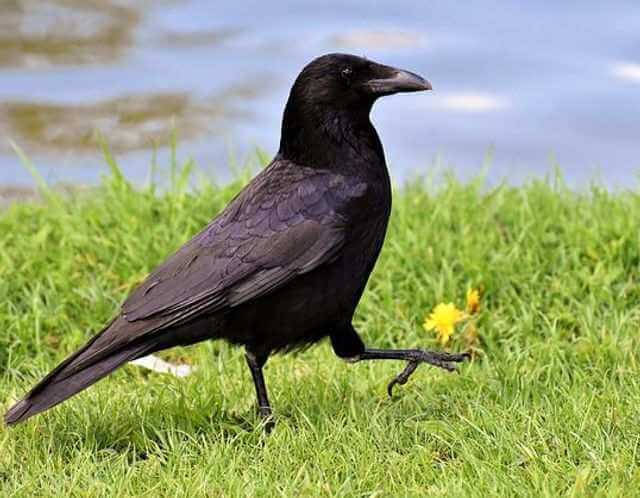Welcome to our expert guide on the 24 backyard winter birds in New Hampshire! As winter blankets New Hampshire in snow, it also brings forth a diverse array of avian visitors to backyard feeders and habitats.
In this comprehensive guide, we’ll explore the fascinating world of New Hampshire’s winter birdlife, featuring 24 species commonly observed during the colder months.
From vibrant cardinals to agile chickadees, learn about their behaviors, habitats, and survival strategies in the face of winter’s challenges.
Whether you’re a seasoned birder or a newcomer to birdwatching, join us as we celebrate the beauty and resilience of New Hampshire’s backyard winter birds.
Table of Contents
- 1 Backyard Winter Birds in New Hampshire
- 1.1 Black-capped Chickadee
- 1.2 Blue Jay
- 1.3 Downy Woodpecker
- 1.4 Dark-eyed Junco
- 1.5 White-breasted Nuthatch
- 1.6 Tufted Titmouse
- 1.7 American Goldfinch
- 1.8 Northern Cardinal
- 1.9 American Crow
- 1.10 Mourning Dove
- 1.11 Hairy Woodpecker
- 1.12 Red-breasted Nuthatch
- 1.13 Red-bellied Woodpecker
- 1.14 European Starling
- 1.15 House Finch
- 1.16 House Sparrow
- 1.17 American Robin
- 1.18 Eastern Bluebird
- 1.19 American Tree Sparrow
- 1.20 White-throated Sparrow
- 1.21 Rock Pigeon
- 1.22 Song Sparrow
- 1.23 Carolina Wren
- 1.24 Common Raven
- 2 Author
Backyard Winter Birds in New Hampshire
Black-capped Chickadee
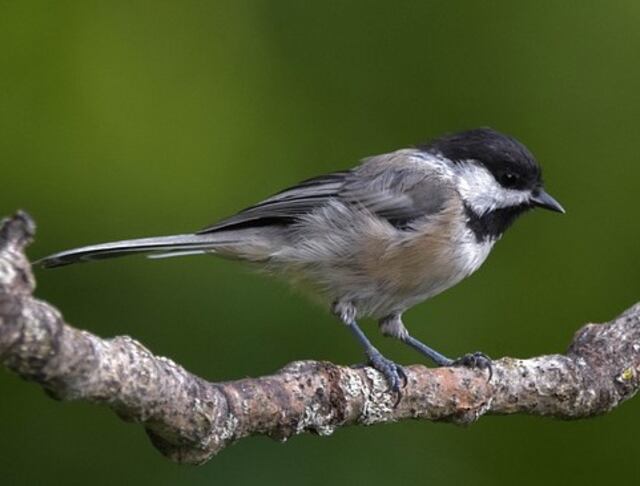
- Length: 4.7-5.9 in (12-15 cm)
- Weight: 0.3-0.5 oz (9-14 g)
- Wingspan: 6.3-8.3 in (16-21 cm)
- Scientific Name: Poecile atricapillus
- Frequency of Occurrence: 61.23%(Statistic by: eBird)
- Where To Find Them: Some places where you can see this species include White Mountain National Forest, and Mount Monadnock. If you’re interested in observing them up close, be sure to visit these locations during the morning or early evening when they are most active.
- How to Attract Them: If you want to attract a black-capped chickadee to your yard in winter, you’ll need some bird feeders with whole or shelled sunflower seeds, raisins, suet or peanut butter. These birds like to eat fresh food and will come to feed if they see it. You can also try setting up a birdbath with fresh water.
General Information: The Black-capped Chickadee is a small, bird that resides in the Northern Hemisphere. This chickadee is found in a variety of habitats, including woodlands, heaths, and gardens. The Black-capped Chickadee is a primarily omnivorous bird and consumes a wide variety of food such as seeds, berries, insects, invertebrates, and occasionally carrion.
They tend to be active during the morning and evening hours. These birds are cavity nesters that mate for life, and typically have one offspring per year. The chickadee will grow to be about 14 grams in weight, and has an average lifespan of about 3 years.
Handpicked Related Post: Unique Black-capped Chickadee Facts You Need To Know!
Blue Jay
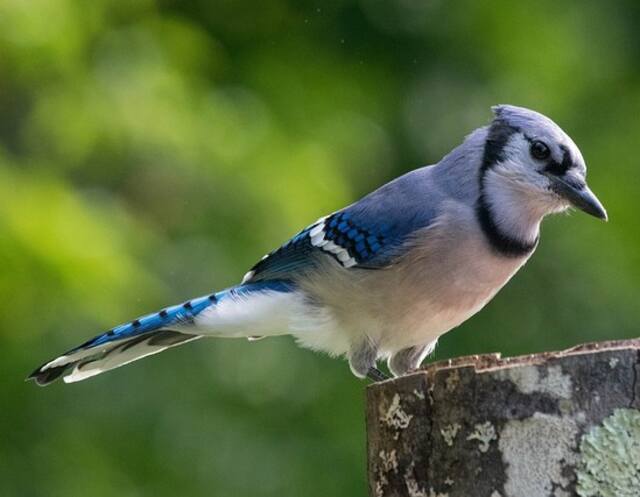
- Length: 9.8-11.8 in (25-30 cm)
- Weight: 2.5-3.5 oz. (70-100 g)
- Wingspan: 13.4-16.9 in (34-43 cm)
- Scientific Name: Cyanocitta cristata
- Frequency of Occurrence: 42.71%
- Where To Find Them: There are several locations in New Hampshire where you can view these beautiful birds in their natural habitat. One spot is the Mt. Monadnock State Forest, which has a number of trails that lead to beautiful overlooks with great views of the surrounding countryside.
- How to Attract Them: If you’re looking to attract blue jays to your yard in winter, here are some tips: Install a bird feeder with black oil sunflower seeds, corn, peanuts, and acorns. These foods are favorites of blue jays and other birds in the winter. Keep your bird feeder clean and free from debris. Blue jays prefer clean surroundings to eat from.
General Information: The blue Jay ranges throughout most of the eastern and central United States, but is absent from much of the western United States. Although it is not a common bird in many parts of its range, the blue Jay can be found everywhere there are trees or other tall objects for perching.
The diet of the blue Jay includes insects, small vertebrates, and fruit. Insects make up the bulk of its diet, but it also eats mice, birds eggs and nestlings. It consumes large quantities of berries and seeds, especially during the winter months, when other food sources are scarce.
Handpicked Related Post:
- 15 Best Bird Feeders For Blue Jays (Tried & Tested 2022)
- What Attracts Blue Jays to your Yard?(Expert Tips)
- What Does A Blue Jay Eat? (10 Favorite Foods Revealed!)
Downy Woodpecker
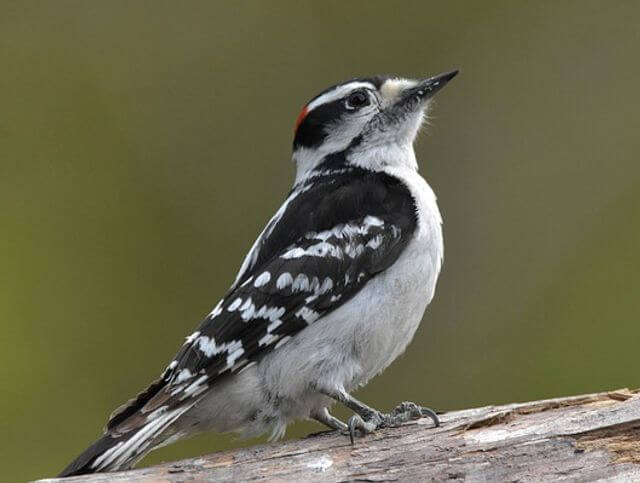
- Length: 5.5-6.7 in (14-17 cm)
- Weight: 0.7-1.0 oz. (21-28 g)
- Wingspan: 9.8-11.8 in (25-30 cm)
- Scientific Name: Picoides pubescens
- Frequency of Occurrence: 40.05%
- Where To Find Them: Downy Woodpeckers are found throughout New Hampshire, but some of the best locations to see them include the White Mountains, Merrimack Valley, and the North Country.
- How to Attract Them: Downy Woodpecker are attracted to bird feeders with black oil sunflower seeds, millet, peanuts, or peanut butter smeared on a tree. If you have a feeder filled with these types of food, you’re almost guaranteed to see a Downy Woodpecker hanging around your yard in the winter.
General Information: The Downy Woodpecker is a small woodpecker that can be found in most areas of North America. They are common in the boreal and temperate zones, but can also be found in a variety of other habitats including deciduous and coniferous forests, suburban gardens, and even chaparral.
Downy woodpeckers are insectivorous birds that mainly feed on beetles, ants, cockroaches, larvae, and other small arthropods. However, they will also consume small vertebrates if they find them while foraging.
Handpicked Related Post: How to Attract Downy Woodpeckers to Your Yard? (Easy!)
Dark-eyed Junco
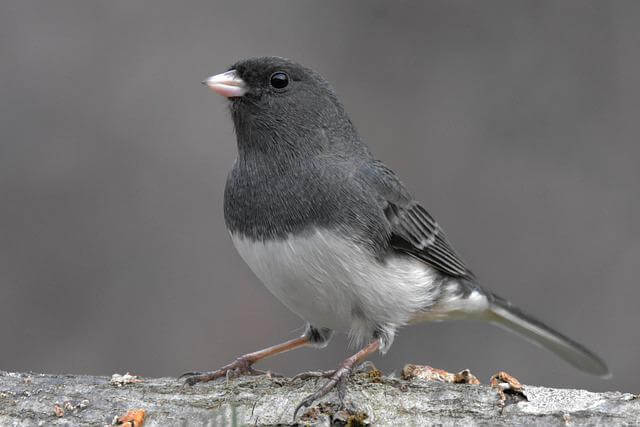
- Length: 5.5-6.3 in (14-16 cm)
- Weight: 0.6-1.1 oz. (18-30 g)
- Wingspan: 7.1-9.8 in (18-25 cm)
- Scientific Name: Junco hyemalis
- Frequency of Occurrence: 40.03%
- Where To Find Them: These beautiful birds can be found in a variety of habitats, but two good places to look are the White Mountains and the Lakes Region. In the White Mountains, look for them around Mount Washington and in Crawford Notch. In the Lakes Region, they can be found along lakes like Winnipesaukee and Sunapee as well as in forests.
- How to Attract Them: If you’re looking to attract Dark-eyed Juncos to your yard in winter, one key strategy is to provide a platform feeder with hulled sunflower seed and white proso millet. Cracked corn can also be a great food option for these birds, as they like to feed on the ground. Keep in mind that these birds will usually only visit a feeder when there are other birds nearby, so make sure your feeder is placed in an area where they’ll find it.
General Information: The Dark-eyed Junco is a common songbird in North America. It ranges from southern Canada to the Gulf of Mexico, south to Central America, and west to the Rocky Mountains. This bird is found in a variety of habitats, from heavily forested areas to open fields. The Dark-eyed Junco feeds on a wide variety of food items, including seeds, insects, and fruit.
This bird is an excellent flier and can often be seen soaring through the air. This bird also has a keen sense of hearing and can spot predators long before they attack. The Dark-eyed Junco is a fairly social bird and often nests in groups.
Handpicked Related Post: Fun Facts About Dark-eyed Juncos
White-breasted Nuthatch
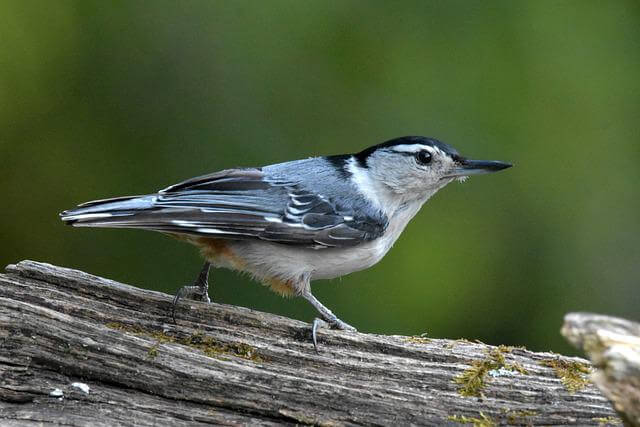
- Length: 5.1-5.5 in (13-14 cm)
- Weight: 0.6-1.1 oz. (18-30 g)
- Wingspan: 7.9-10.6 in (20-27 cm)
- Scientific Name: Sitta carolinensis
- Frequency of Occurrence: 39.55%
- Where To Find Them: In Woodstock, for example, the nuthatches can often be found perched on branches high in trees. This is a great place to watch them during the morning or early evening hours. In Hanover, another popular spot for spotting white-breasted nuthatches, you’ll likely find them perched atop telephone poles or other tall structures near parks and other open spaces.
- How to Attract Them: If you’re looking to attract a White-breasted Nuthatch to your yard in winter, you can try using a platform feeder with nuts, sunflower seeds, mealworms, or a suet feeder with insect suet. These feeders will provide the bird with a variety of food options, and may help keep it happy and healthy during the colder months.
General Information: The white-breasted nuthatch is a small bird that can be found in the eastern and northern United States. This species of bird is popular for its brightly colored tail feathers. The white-breasted nuthatch ranges across North America, from southeastern Alaska to central Florida. It prefers lowland areas, but will also inhabit rocky cliffs and woodlands.
White-breasted nuthatches eat a variety of foods, including nuts, seeds, insects, and fruits. They enjoy figs and grapes in particular. White-breasted nuthatches are often seen foraging for food in the morning or late afternoon.
Handpicked Related Post: How to Attract Nuthatches to your Backyard? Expert Tips!
Tufted Titmouse
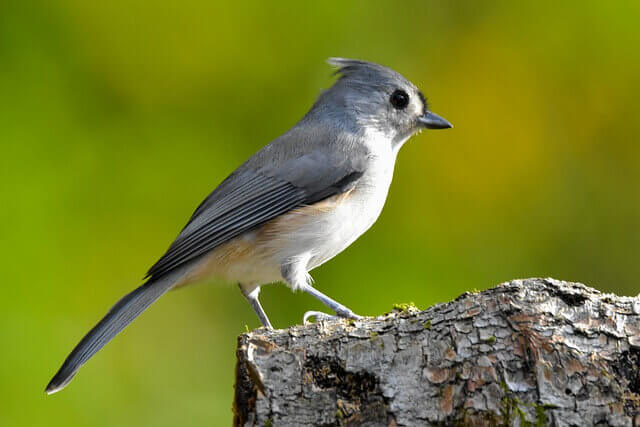
- Length: 5.5-6.3 in (14-16 cm)
- Weight: 0.6-0.9 oz. (18-26 g)
- Wingspan: 7.9-10.2 in (20-26 cm)
- Scientific Name: Baeolophus bicolor
- Frequency of Occurrence: 38.77%
- Where To Find Them: The best place to start is likely the White Mountains National Forest, where the titmouse is found throughout most of its range. Elsewhere in the state, look for this bird around wet meadows and woodlands.
- How to Attract Them: Start by providing a variety of bird feeders with different types of food. This will keep the titmice interested and will also provide them with the essential nutrients they need to survive winter. Include sunflower seeds, peanuts, safflower seeds, or nyjer in your feeder offerings. These are all favorites of the tufted titmouse and will keep them occupied for hours on end. Make sure your bird feeder is well-placed in an accessible spot; this will encourage the titmice to visit regularly.
General Information: The Tufted Titmouse ranges across the eastern United States, from southern New England all the way down to Florida. The titmouse is a small passerine bird that typically inhabits mixed woodlands, but it can also be found in residential areas, especially near gardens and orchards. The diet of the tufted titmouse includes insects, seeds, nuts, berries and fruit.
For insects, the titmouse favors Lepidoptera such as moths and butterflies. Seeds are a major part of their diet, with chickweed being a favorite. Nuts are also consumed in considerable quantities, including pine nuts, hickory nuts and walnuts. Berries make up a small part of their diet, but are still an important part of their overall nutritional needs.
Handpicked Related Post: How to Attract Tufted Titmouse to my Yard? (Explained)
American Goldfinch
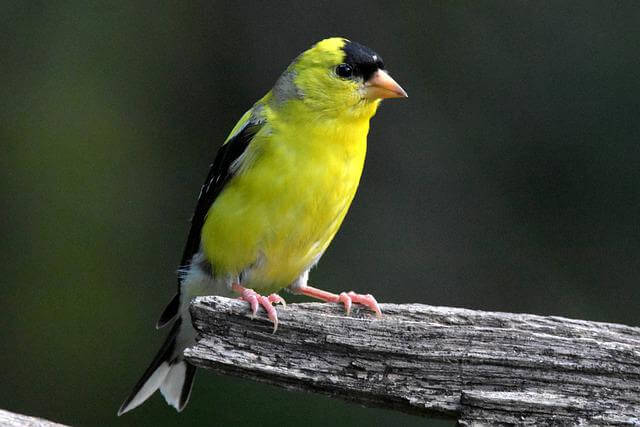
- Length: 4.3-5.1 in (11-13 cm)
- Weight: 0.4-0.7 oz. (11-20 g)
- Wingspan: 7.5-8.7 in (19-22 cm)
- Scientific Name: Spinus tristis
- Frequency of Occurrence: 32.65%
- Where To Find Them: The Merrimack River Valley – This valley stretches from the Massachusetts border south to Concord and includes some of the most heavily forested areas of New Hampshire.
- How to Attract Them: If you’re looking to attract American Goldfinch to your yard in winter, there are a few things you can do. One option is to put up a bird feeder with thistle and nyjer mixed in. This will provide the birds with plenty of food sources and help keep them occupied during the cold months. Another option is to add sunflower seeds to your feeder.
General Information: The American Goldfinch ranges in North America from the Yukon to Panama and throughout much of Central America. They are common in the eastern U.S., breeding as far south as Georgia and Florida. The range extends west to the Rocky Mountains and north to British Columbia and Alaska. These birds are monogamous, forming pairs for life. They nest in a variety of locations, but most commonly in shrubs or small trees near water.
American Goldfinches eat a variety of insects, nyjer or thistle seeds. Their diet changes with the seasons, with more insects during the summer and more weed seeds in winter. In addition to their natural food sources, American Goldfinches often consume birdseed at feeders.
Handpicked Related Post: Interesting American Goldfinch Facts You Need to Know!
Northern Cardinal

- Length: 8.3-9.1 in (21-23 cm)
- Weight: 1.5-1.7 oz. (42-48 g)
- Wingspan: 9.8-12.2 in (25-31 cm)
- Scientific Name: Cardinalis cardinalis
- Frequency of Occurrence: 31.52%
- Where To Find Them: In eastern New Hampshire, the cardinal is most common near the small towns of Berlin and Rochester. In western New Hampshire, the cardinal can be found in both rural and urban areas around Manchester and Nashua.
- How to Attract Them: If you’re looking to attract Northern Cardinals to your yard in winter, a platform feeder with safflower seeds is a great option. Black oil sunflower seeds are another good choice, as they provide plenty of energy for the birds. White milo can also be a hit, as it’s high in protein and contains no sugar. Finally, cracked corn can provide essential nutrients to the birds while keeping them entertained.
General Information: The Northern Cardinal Range stretches from the Appalachian Mountains in the east to the Great Lakes in the west, and includes portions of nine states. The range is a mosaic of forests, meadows, and mountains with a variety of habitat types including oak-hickory forests, coniferous forests, wetlands, and upland meadows. The Northern Cardinals are insectivorous, mainly eating spiders and other small insects.
They also eat fruits, berries, and nectar. The female Cardinal builds a large cup-shaped nest high in a tree or on top of a pole. The female lays two to five eggs which are incubated, and take about 11-13 days to hatch. The young Cardinals leave the nest after about 10 days and become independent quickly.
Handpicked Related Post:
- Best Birdhouse for Cardinals 2022 (Tested And Rated)
- 10 Best Bird Feeders for Cardinals (Rated for 2022)
- Cardinal Bird Facts Every Birdwatcher Should Know!
American Crow
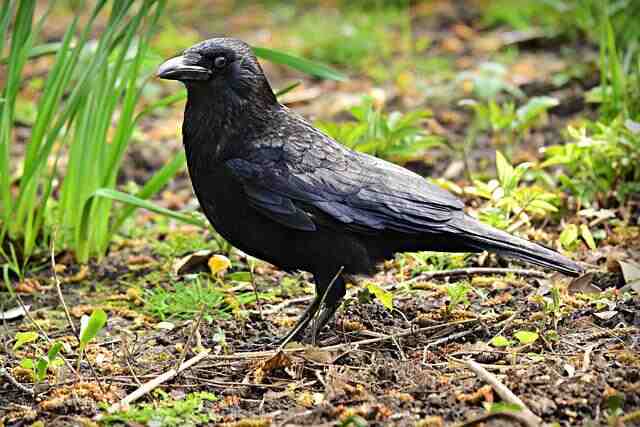
- Length: 15.8-20.9 in (40-53 cm)
- Weight: 11.2-21.9 oz. (316-620 g)
- Wingspan: 33.5-39.4 in (85-100 cm)
- Scientific Name: Corvus brachyrhynchos
- Frequency of Occurrence: 30.91%
- Where To Find Them: One of the best places to see American Crows in New Hampshire is at the White Mountains National Forest. Here, you can find several good viewing spots, including Mt. Washington and Pinkham Notch.
- How to Attract Them: With the cold weather approaching, many homeowners are thinking about how to attract American Crows to their yards. One popular way is to install a platform feeder with corn, peanuts or sunflower seeds. Here’s how it works: The American Crow will see the feeder as a safe place to find food in the cold weather. In return, you’ll get a great view of these intelligent birds and some interesting photo opportunities.
General Information: The American Crow is a common bird found in many parts of the world. It ranges from the tundra of Alaska to the rainforests of Central America and has been seen as far south as Florida. The American Crow is a common bird found in many parts of the world.
The American Crow feeds on a variety of things, including earthworms, insects, small animals, seeds, and garbage. It usually forages in open areas, but will also scavenge food if it finds it. The American Crow is a social bird and often aggregates in large groups.
Handpicked Related Post: How To Attract Crows To Your Backyard: Expert Tips!
Mourning Dove

- Length: 9.1-13.4 in (23-34 cm)
- Weight: 3.4-6.0 oz. (96-170 g)
- Wingspan: 17.7 in (45 cm)
- Scientific Name: Zenaida macroura
- Frequency of Occurrence: 29.80%
- Where To Find Them: Keene State Park – This state park has a great variety of habitats, including open fields, woodlands, and swamps. The park also has a pond that is home to several species of birds, including the mourning dove. Pemigewasset Valley Wilderness – This preserve is home to many different types of birds, as well as the mourning dove. It’s an excellent place to see this species in its natural habitat.
- How to Attract Them: Winter is the perfect time to attract mourning doves to your yard. Platform feeders with sunflower seeds, safflower, and nyjer can provide a steady supply of food. Cracked corn, peanuts, and millet can also be a great source of nutrition for these birds. Be sure to provide plenty of water in winter, as these birds often drink more than usual in cold weather.
General Information: The mourning dove is a common sight in the eastern United States. The range of this bird extends from the mid-Atlantic states to Florida, and west to Texas. Mourning doves are inhabitants of both woodlands and urban areas. They prefer to live near water sources, such as rivers and lakes.
Mourning doves feed on seeds, fruit, waste grain, and insects. They are particularly fond of corn and other grains. These birds form social colonies during the winter months. They are very active fliers and can travel long distances without resting.
Handpicked Related Post: Facts About Mourning Doves – 10 Things You Need To Know!
Hairy Woodpecker
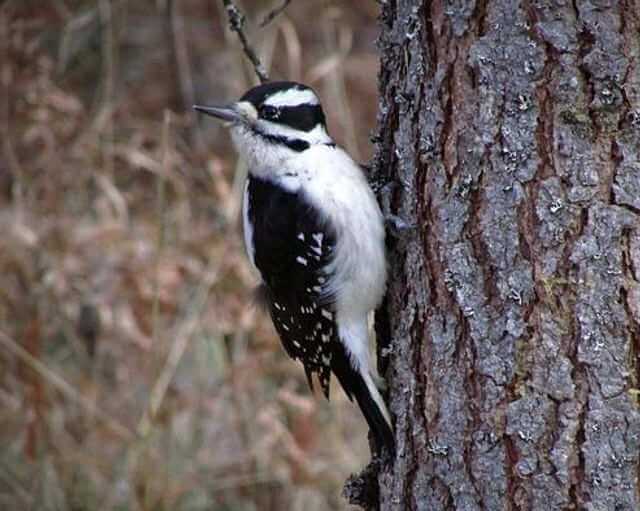
- Length: 7.1-10.2 in (18-26 cm)
- Weight: 1.4-3.4 oz. (40-95 g)
- Wingspan: 13.0-16.1 in (33-41 cm)
- Scientific Name: Leuconotopicus villosus
- Frequency of Occurrence: 25.96%
- Where To Find Them: Locations that the Hairy Woodpecker can be found in include White Mountains National Forest, and Mount Washington. All three of these places offer good opportunities for spotting this woodpecker in action.
- How to Attract Them: If you’re looking to attract the hairy woodpecker to your yard in winter, one way to do it is to give them a tasty treat. Try feeding them peanuts or black oil sunflower seeds, which will provide them with the energy they need to survive the cold weather. You can also try using a suet feeder with insect suet, which will provide them with the nutrients they need to thrive during this time of year.
General Information: The Hairy Woodpecker is a common resident of the boreal forests of North America. The bird ranges from the Yukon Territory in Canada to the eastern half of Texas and west to Montana. The woodpecker is found in mixed hardwood and coniferous forests, but prefers areas with plenty of tree bark for feeding on insects, particularly wood-boring beetles.
The bird also eats berries and seeds. It is a terrestrial bird that forages for food on the ground or in trees. The Hairy Woodpecker is a shy bird that avoids humans and other large animals. It nests in tree cavities, laying 2 to 3 eggs. Young birds fledge after about two months and are able to fly after four months.
Red-breasted Nuthatch
- Length: 4.3 in (11 cm)
- Weight: 0.3-0.5 oz. (8-13 g)
- Wingspan: 7.1-7.9 in (18-20 cm)
- Scientific Name: Sitta canadensis
- Frequency of Occurrence: 17.50%
- Where To Find Them: This small passerine can be seen throughout most of New Hampshire, but some of the best places to see them are in the White Mountains.
- How to Attract Them: There are a few things you can do to attract the Red-breasted Nuthatch to your yard in winter. One way is to provide them with peanuts and sunflower seeds. These birds love to eat these types of nuts and seeds, so providing them will keep them happy and healthy. Another thing you can do is put out some suet cakes or blocks.
General Information: The red-breasted nuthatch is a bird species typically found in the eastern United States. This small bird ranges from southeastern Canada to Florida and west to Texas. This nuthatch feeds mainly on seeds, but will also eat insects. They are often found in coniferous forests, but have been known to inhabit deciduous woods as well.
Nuthatches are very active during the day, constantly moving around the tree they are in. They are very social birds and often gather in large groups during the winter months.
Handpicked Related Post: How to Attract Nuthatches to your Backyard? Expert Tips!
Red-bellied Woodpecker
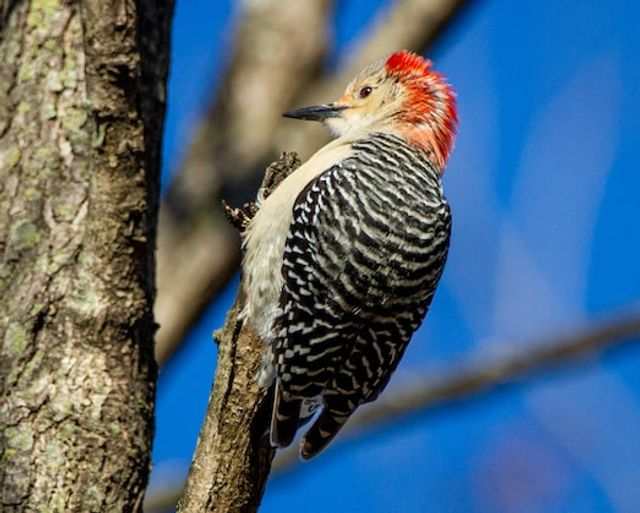
- Length: 9.4 in (24 cm)
- Weight: 2.0-3.2 oz. (56-91 g)
- Wingspan: 13.0-16.5 in (33-42 cm)
- Scientific Name: Melanerpes carolinus
- Frequency of Occurrence: 15.44%
- Where To Find Them: Red-bellied Woodpecker are found in many locations throughout New Hampshire, but the most popular spots for viewing these birds are at Mount Monadnock State Park, and Kancamagus Scenic Byway.
- How to Attract Them: Red-bellied Woodpecker are some of the most difficult birds to attract to your yard in winter. However, providing a combination of sunflower seed, suet, and peanuts can help make them come to your feeder.
General Information: The Red-bellied Woodpecker ranges across most of the eastern two-thirds of the United States. This woodpecker is found in a variety of habitats, from mixed forests to open areas with scattered trees. The diet of this bird includes insects, fruits, nuts and seeds. This species is often seen foraging for food on the ground or in low branches near the ground. It taps on tree trunks with its beak, listening for prey that may be hidden among the bark.
When it finds what it’s looking for, it pecks at the object until it can remove it. The red-bellied woodpecker is a social bird that lives in colonies of up to 15 birds. These colonies are generally composed of pairs or family groups that care for young together.
Handpicked Related Post: How to Attract Red-bellied Woodpeckers to your Yard?
European Starling
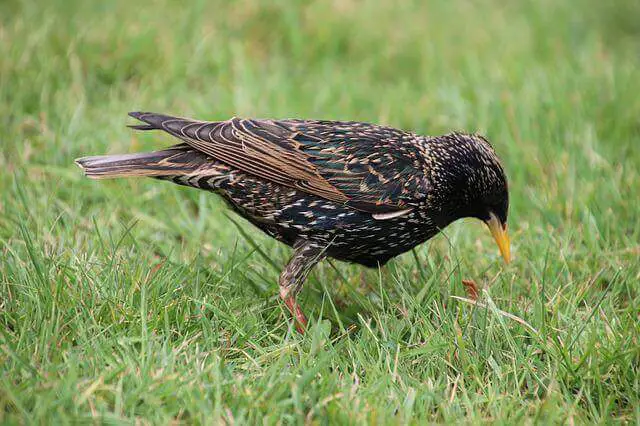
- Length: 7.9-9.1 in (20-23 cm)
- Weight: 2.1-3.4 oz. (60-96 g)
- Wingspan: 12.2-15.8 in (31-40 cm)
- Scientific Name: Sturnus vulgaris
- Frequency of Occurrence: 15.29%
- Where To Find Them: The European Starling is a beautiful bird that can be found all over New Hampshire. Some of the best places to see them are in Claremont, Nashua, and Peterborough. These towns have a lot of open areas where these birds can feed and nest.
- How to Attract Them: European Starlings are a beautiful bird that can add an element of fun to your yard in winter. They are attracted to both sunflower seed and suet, so providing these two items will help attract them to your yard. You can also try filling a feeder with these types of food, or scattering seeds on the ground near your fence or other obstruction.
General Information: The red-bellied woodpecker ranges throughout much of North America, but is most common in the eastern United States and Canada. The European starling is a migratory bird that can be found throughout much of Europe, Asia, and parts of Africa. It’s main habitat is open country, preferring areas with plenty of trees and bushes for nesting, but it can also be found near human settlements.
The European Starling diet consists mainly of insects, but it will also eat small fruits and seeds. Insects are mainly caught by flying through the air or landing on a perch and picking them up with its beak. Seeds are eaten when they fall from fruit trees or are found on the ground.
Handpicked Related Post: How to Attract Red-bellied Woodpeckers to your Yard?
House Finch
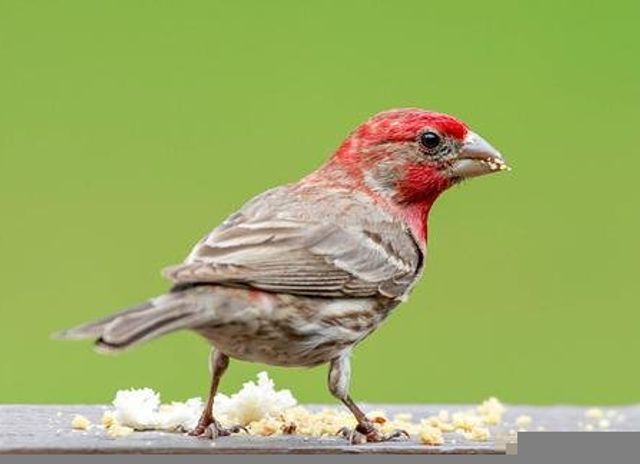
- Length: 5.1-5.5 in (13-14 cm)
- Weight: 0.6-0.9 oz. (16-27 g)
- Wingspan: 7.9-9.8 in (20-25 cm)
- Scientific Name: Haemorhous mexicanus
- Frequency of Occurrence: 14.72%
- Where To Find Them: House Finch can be seen in a few locations in New Hampshire. The best place to see them is at the White Mountains National Forest. They can also be found in the Merrimack River Valley.
- How to Attract Them: These birds are attracted to feeders with Black-oil Sunflower, safflower, thistle. One way to attract these birds is to put out a feeder filled with their favorite food. Another way to attract them is to place some birdhouses in your yard.
General Information: The House Finch is a small bird that ranges across much of North America. The House Finch is found in the southeastern United States all the way up to Manitoba, Canada and throughout most of Central America. In the northwestern part of its range, it can be found as far south as Panama.
The House Finch is usually seen in open areas with plenty of tree cover, such as parks, gardens and orchards. It feeds on a variety of plant material including seeds, buds and fruits. The House Finch is a shy bird and usually stays in its own territory. It has a loud “cheeky” call that can be heard from a long way away.
Handpicked Related Post:
- 9 Best Birdhouse for Finches? (Rated & Tested for 2022)
- How to Attract House Finch to your Yard? (Easy & Fast)
House Sparrow
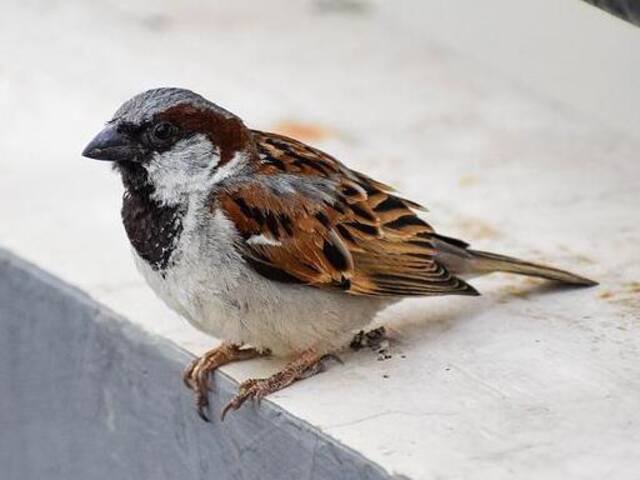
- Length: 5.9-6.7 in (15-17 cm)
- Weight: 0.9-1.1 oz. (27-30 g)
- Wingspan: 7.5-9.8 in (19-25 cm)
- Scientific Name: Passer domesticus
- Frequency of Occurrence: 14.24%
- Where To Find Them: House Sparrows are found throughout New Hampshire, but can be particularly spotted in the following locations: Bartlett Memorial Forest near Stratham. The White Mountains National Forest. Mount Monadnock. The Merrimack Valley.
- How to Attract Them: House Sparrows are a common bird in urban and suburban areas, but can be difficult to attract to your yard in winter. One way to try is by providing feeders with thistle nyjer, safflower, or mealworms. These types of feeders will also serve as sources of food for the birds during the colder months. Make sure to scatter some peanuts in-shell around the feeders as an added attraction.
General Information: House Sparrows are a common bird in many parts of the world, with a wide range of habitats from tropical rainforest to suburban gardens. They are omnivorous and eat a variety of foods, including grains and seeds, our discarded food, and insects.
House Sparrows nests in buildings or on the ground, and they are found in large numbers around human habitation. They forage for food on the ground or in low vegetation, but often access human-made foods such as garbage cans. House Sparrows are monogamous birds that breed in communal colonies.
Handpicked Related Post: How to Attract Sparrows to your Backyard? (Like A Pro)
American Robin
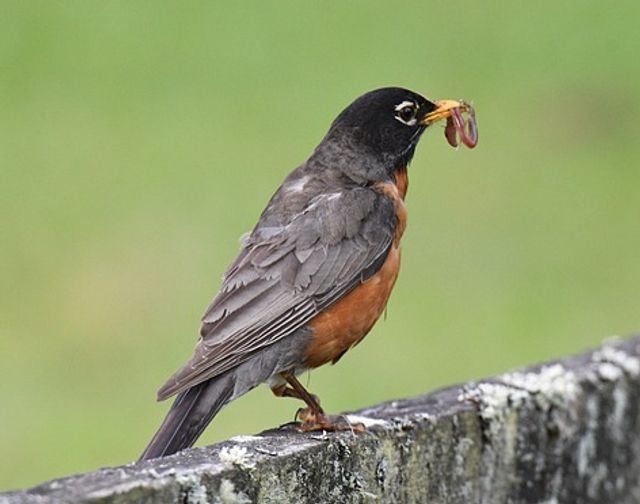
- Length: 7.9-11.0 in (20-28 cm)
- Weight: 2.7-3.0 oz. (77-85 g)
- Wingspan: 12.2-15.8 in (31-40 cm)
- Scientific Name: Turdus migratorius
- Frequency of Occurrence: 12.49%
- Where To Find Them: The American Robin is a common bird found throughout New Hampshire. They can be found in many locations, but some of the most popular spots are the White Mountains, Merrimack Valley, and the Seacoast.
- How to Attract Them: One way to attract the American Robin to your yard in winter is to offer it a platform feeder filled with mealworms. This will provide the bird with an easy meal and plenty of opportunities for socializing. Cracked corn can also be a great food source for the American Robin in winter. Simply scatter some kernels on the ground near the feeder and watch as the birds go wild for them!
General Information: The American Robin is a common bird found throughout North America. It ranges from southern Canada to the highlands of northern Mexico, and from Alaska south to Florida and Texas. This bird is typically associated with open areas such as meadows, parks, and gardens, but can also be found in dense forested areas.
The American Robin’s diet consists mostly of insects, but it also consumes small amounts of vegetation (mainly berries) and earthworms. These birds are very active during the day, but usually retire to a nearby tree at night. They are very social creatures and often form monogamous pairs or family groups.
Handpicked Related Post:
- How To Attract Robins To Your Yard – 7 Best Tips!
- 5 Best Bird Feeders For Robins (Tested & Rated For 2022)
Eastern Bluebird
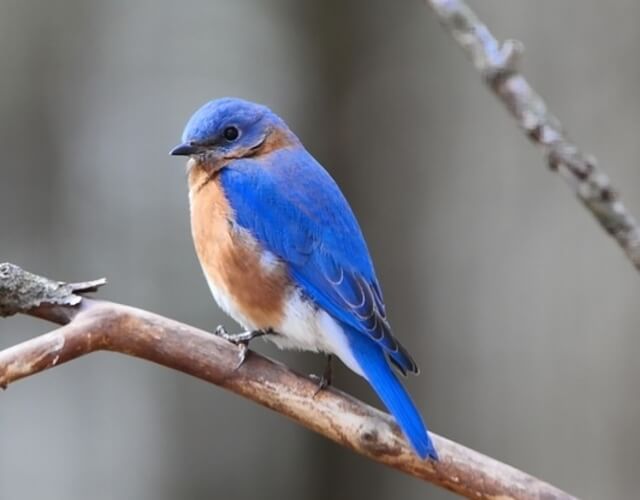
- Length: 6.3-8.3 in (16-21 cm)
- Weight: 1.0-1.1 oz. (28-32 g)
- Wingspan: 9.7-12.5″in. (25-32 cm)
- Scientific Name: Sialia sialis
- Frequency of Occurrence: 11.96%
- Where To Find Them: Eastern Bluebirds can be found in a number of locations in New Hampshire. These include the White Mountains, the North Country, and the Merrimack Valley. In addition, they are common in some suburbs of Concord and Manchester.
- How to Attract Them: Mealworms are a great food for bluebirds because they are high in protein and fat. Suet is a good source of energy for these birds during cold weather. Sunflower hearts can also be a great food option for bluebirds. These items will attract the birds to your yard and give you the opportunity to watch them while they eat.
General Information: The eastern bluebird is a bird found in the United States and southern Canada. The eastern bluebird ranges from Maine south to Florida, west to Oklahoma and Texas, and north to New Brunswick. They are found in both rural and urban areas, as well as woodlands, gardens, and fields. Eastern bluebirds eat insects, wild fruit and berries, and sometimes small birds.
Eastern bluebirds are important for their diet because they help control insect populations. They also eat a lot of fruits and berries that would be wasted if not picked by people. Eastern bluebirds are territorial and can be aggressive when defending their territory against other birds or animals.
Handpicked Related Post:
- How to Attract Eastern Bluebirds to your Yard (Explained)
- 60 Fun Facts About Eastern Bluebirds (You Didn’t Know!)
American Tree Sparrow
- Length: 5.5 in (14 cm)
- Weight: 0.5-1.0 oz. (13-28 g)
- Wingspan: 9.4 in (24 cm)
- Scientific Name: Spizelloides arborea
- Frequency of Occurrence: 11.50%
- Where To Find Them: The American Tree Sparrow can be found at a variety of locations in New Hampshire. A few places where you may be able to see these birds include the White Mountains National Forest and the Merrimack River Valley.
- How to Attract Them: First and foremost, make sure you have a feeder full of millet or sunflower hearts. These types of feeders will appeal to the birds because they provide a high-quality food source. In addition, try scattering nyjer seeds around your yard for added attraction. American Tree Sparrows love this type of bird food!
General Information: The American Tree Sparrow is a common bird in North America. They range from the Great Lakes region to the southeast and west to California. Their habitat includes open areas such as parks, gardens, and fields. The tree sparrows are seed eaters and their diet also includes berries, insects, and other small creatures.
They are active birds that forage for food throughout the day. The American Tree Sparrow is a territorial bird that builds a stick nest in a tree or on the ground.
Handpicked Related Post: 10 Fascinating American Tree Sparrow Facts
White-throated Sparrow
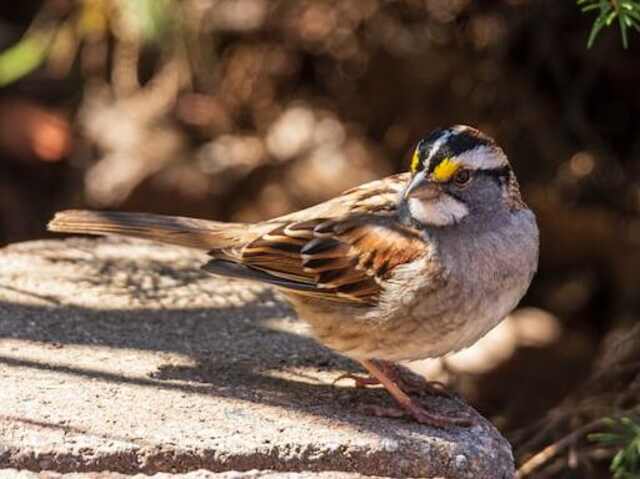
- Length: 6.3-7.1 in (16-18 cm)
- Weight: 0.8-1.1 oz. (22-32 g)
- Wingspan: 7.9-9.1 in (20-23 cm)
- Scientific Name: Zonotrichia albicollis
- Frequency of Occurrence: 9.56%
- Where To Find Them: White-throated Sparrows are commonly found in the northeast United States, and can be found throughout New Hampshire. These birds can be seen in a variety of locations, such as forests, open fields, and suburban areas.
- How to Attract Them: One way to attract white-throated sparrows to your yard in winter is by using bird feeders that contain millet and black oil sunflower seeds. These birds love these types of feeders, and will come to eat their fill. You can also try placing a bird bath in your yard.
General Information: The white-throated sparrow is a common bird found throughout the eastern United States. The range of this bird extends from southern Canada south to the Gulf of Mexico, and west to Texas and Oklahoma. The white-throated sparrow feeds primarily on insects, but will also eat seeds and fruit.
In the winter, it typically eats seeds from deciduous trees. This bird is usually seen in open areas such as fields, but can also be found in wooded areas. White-throated Sparrows are social birds that forage for food in groups. They are often seen communicating with each other by calling or singing.
Rock Pigeon
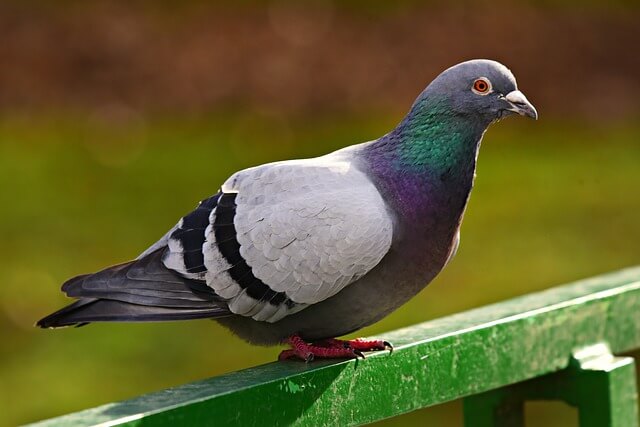
- Length:11.8-14.3 in(30-36 cm)
- Weight: 9.3-13.4 oz. (265-380 g)
- Wingspan: 19.7-26.5 in (50-67 cm)
- Scientific Name: Columba livia
- Frequency of Occurrence: 9.51%
- Where To Find Them: They are commonly seen in the White Mountains, but they can also be found in Concord and Manchester.
- How to Attract Them: If you want to attract Rock Pigeons to your yard in winter, try using a platform feeder filled with sunflower, safflower, or peanut seeds. You can also feed them cracked corn or millet. Make sure the feeders are out of reach of cats and dogs, and keep an eye on them to make sure they’re being fed regularly.
General Information: The Rock Pigeon Range is a large area in the central United States that is mostly made up of cliffs and hills. The range is home to a variety of different habitats, including grasslands, deciduous forests, chaparral, and wetlands.
The Rock Pigeon is an opportunistic bird that eats a variety of foods.
It mainly eats grasses, berries, fruits, grains, and weeds. It also consumes insects and worms. The Rock Pigeon is a social bird that lives in groups of up to 20 birds. Groups usually consist of either monogamous couples or groups of females with their younglings.
Handpicked Related Post: Birds that look like Pigeons (Photos, ID & Stats)
Song Sparrow
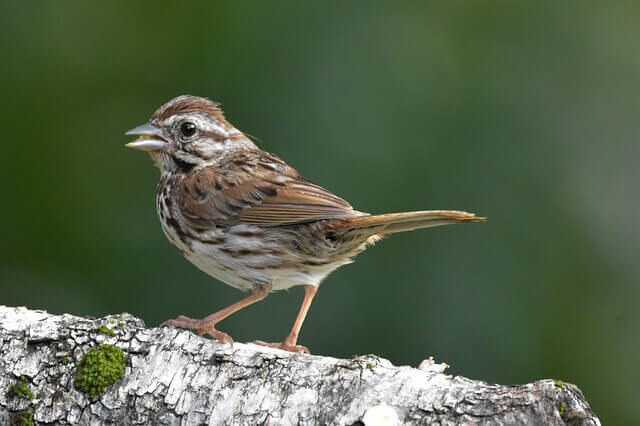
- Length:4.7-6.7 in (12-17 cm)
- Weight: 0.4-1.9 oz. (12-53 g)
- Wingspan: 7.1-9.4 in (18-24 cm)
- Scientific Name: Melospiza melodia
- Frequency of Occurrence: 7.97%
- Where To Find Them: Song Sparrows are typically seen in open areas with plenty of vegetation, such as fields, orchards, and gardens. They can also be seen in parks and other public areas.
- How to Attract Them: There are a number of ways to attract song sparrows to your yard in winter. One way is to create a platform feeder that offers sunflower or safflower seeds. A couple of cups of these seeds will keep the sparrows coming for hours, and they’ll also be eating some nutritious foods too. You can also offer millet, thistle, and cracked corn. These are all high-energy foods that will keep the sparrows entertained and hopefully providing some food for them too.
General Information: The range of the Song Sparrow, (Melospiza melodia), spans across much of the eastern and central United States. They are common in a variety of habitats including grasslands, deciduous and hardwood forests, and suburban gardens. The Song Sparrow is an opportunistic feeder that eats a variety of insects, seeds, and fruits.
They are social birds that forage in groups. The Song Sparrow is a monogamous species that pairs for life. They typically nest in low trees but can also use artificial structures such as birdhouses or nests made from moss or lichen.
Carolina Wren
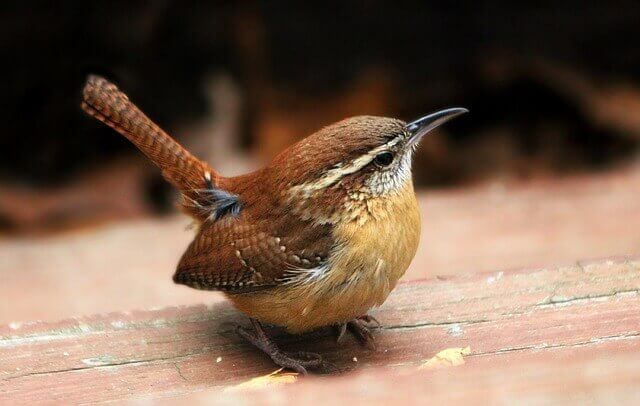
- Length: 4.7-5.5 in (12-14 cm)
- Weight: 0.6-0.8 oz. (18-22 g)
- Wingspan: 11.4 in (29 cm)
- Scientific Name: Thryothorus ludovicianus
- Frequency of Occurrence: 7.43%
- Where To Find Them: The Carolina Wren is a common bird in New Hampshire and can be seen at many locations. The best places to see this bird are in the forests near Concord, Nashua, and Manchester, as well as in the White Mountains of New Hampshire.
- How to Attract Them: Getting Carolina Wren to visit your yard in winter can be a bit of a challenge, but with a little effort you can make it happen. One key element is providing them with plenty of food and shelter. A platform feeder filled with mealworms or sunflower seeds will keep the wrens happy and fed, while suet can also provide important energy for cold weather birds.
General Information: The Carolina wren ranges throughout eastern North America and has a variety of habitats, including deciduous and coniferous woods, suburbs, and even urban areas. This small bird is well-known for its agreeable song, but it is also known for its diet, which includes insects, larvae, spiders, berries and fruit.
The Carolina wren is a shy bird that prefers to forage in peace. However, when disturbed or threatened, it can be aggressive towards predators. This bird nests in colonies and raises young together.
Handpicked Related Post: How to Attract Wrens to your Backyard? (Expert’s Guide)
Common Raven
- Length: 22.1-27.2 in (56-69 cm)
- Weight: 24.3-57.3 oz. (689-1625 g)
- Wingspan: 45.7-46.5 in (116-118 cm)
- Scientific Name: Corvus corax
- Frequency of Occurrence: 7.41%
- Where To Find Them: Common Raven can be found throughout New Hampshire, except for the White Mountains. Locations where you are likely to see this bird include towns and rural areas in the north-central and eastern parts of the state, as well as the Merrimack Valley.
- How to Attract Them: If you’re looking to attract a Common Raven to your yard in winter, consider using a platform feeder filled with meal worms and sunflower seeds. The birds will love the tasty morsels, and the added bonus of watching the birds from your porch or window is sure to please. Another idea is to spread some suet around outside near a tree or other large object where ravens like to perch. Keep in mind that these birds are opportunistic feeders, so offering them food regularly throughout the winter is always a good idea!
General Information: The Common Raven is a common bird found in most parts of the world. The raven has a wide range and can be seen in many different habitats, including forests, wetlands, urban areas, and agricultural areas. The raven primarily eats arthropods, seeds, grain, small animals, and sometimes fruits.
The raven is intelligent and can be quite territorial. It is often seen flying high in the sky or on the ground studying its surroundings. The raven is also known for its distinctive call, which can be heard throughout much of North America.
Handpicked Related Post: 18 Fun Facts About Ravens That Will Amaze You
Related Post: Most Common Birds in New Hampshire: A Complete Guide

